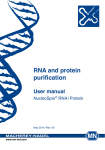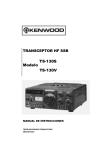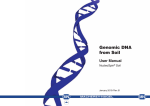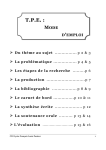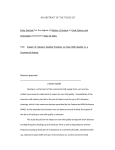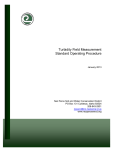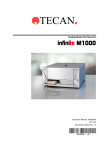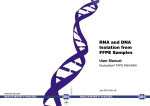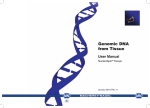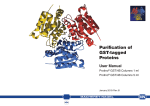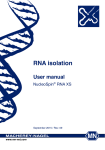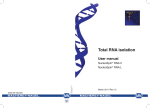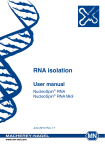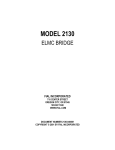Download Total RNA and Protein Isolation
Transcript
Total RNA and Protein Isolation User Manual NucleoSpin® RNA/Protein October 2008/Rev. 05 MACHEREY-NAGEL MN Total RNA and Protein Isolation Protocol-at-a-glance (Rev. 05) NucleoSpin® RNA/ Protein 1 Homogenization of sample 2 Cell lysis 3 Filtration of lysate 30 mg 350 µl RP1 3.5 µl ß-mercaptoethanol 1 min 11,000 x g 4 Adjust binding conditions 5 Bind RNA 350 µl ethanol (70 %) 30 s 11,000 x g RNA Purification (RNA bound to the silica membrane) Protein Purification (protein in the column flow-through) 6 10 Desalt silica membrane 350 µl MDB Precipitate protein 1 vol PP RT 10 min 1 min 11,000 x g 7 Digest DNA 95 µl DNase reaction mixture RT 15 min 8 Wash and dry silica membrane 1st wash 2nd wash 3 wash rd 5 min 11,000 x g 11 Wash protein 200 µl RA2 12 Dry protein pellet 13 Prepare protein sample 2 min 11,000 x g 9 Elute highly pure RNA 500 µl ethanol (50 %) 1 min 11,000 x g 200 µl RA2 600 µl RA3 30 s 11,000 x g 10 - 700 µl flow-through RT 5 - 10 min 20 - 100 µl PLB-TCEP 3 min 95 - 98 °C 1 min 11,000 x g 60 µl H2O (RNase-free) 1 min 11,000 x g MACHEREY-NAGEL GmbH & Co. KG • Neumann-Neander-Str. 6-8 • D-52355 Düren • Germany Tel.: +49 (0) 24 21 969 270 • www.mn-net.com • e-mail: [email protected] MN Total RNA and Protein Isolation Table of contents 1 2 Components 4 1.1 Kit contents 4 1.2 Reagents, consumables, and equipment to be supplied by user 5 1.3 About this User Manual 5 Product description 6 2.1 The basic principle 6 2.2 Kit specifications 7 2.3 Handling, preparation, and storage of starting materials 11 2.4 Guideline for appropriate sample amount, precipitation, and resolubilization volume for protein isolation 13 2.5 Elution procedures 14 3 Storage conditions and preparation of working solutions 15 4 Safety instructions – risk and safety phrases 17 5 Protocols 18 5.1 Total RNA and protein purification from cultured cells and tissue with NucleoSpin® RNA/ Protein 5.2 Support protocol NucleoSpin RNA/ Protein: Total RNA preparation from biological fluids (e.g. serum, culture medium) 18 ® 24 5.3 Support protocol NucleoSpin RNA/ Protein: Total RNA preparation from up to 109 bacterial cells 25 5.4 Support protocol NucleoSpin RNA/ Protein: Total RNA preparation from up to 5 x 107 yeast cells 27 5.5 Support protocol NucleoSpin RNA/ Protein: Total RNA preparation from RNAlater® treated samples 28 ® ® ® 5.6 Support protocol NucleoSpin RNA/ Protein: rDNase digestion in solution 29 ® 6 Appendix 31 6.1 Protein quantification 31 6.2 Troubleshooting 39 6.3 References 43 6.4 Ordering information 44 6.5 Product use restriction / warranty 45 MACHEREY-NAGEL – 10 / 2008, Rev. 05 3 Total RNA and Protein Isolation 1 Components 1.1 Kit contents NucleoSpin® RNA/ Protein 10 preps 50 preps 250 preps 740933.10 740933.50 740933.250 9 ml 45 ml 225 ml 2 x 1 ml 7.5 ml 5 x 7.5 ml 2 x 14 mg 107 mg 5 x 107 mg Lysis Buffer RP1 10 ml 25 ml 125 ml Wash Buffer RA2 15 ml 15 ml 80 ml Wash Buffer RA3 (Concentrate)* 5 ml 12.5 ml 3 x 25 ml Membrane Desalting Buffer MDB 10 ml 25 ml 125 ml Reaction Buffer for rDNase 3 ml 7 ml 35 ml 1 vial (size C) 1 vial (size D) 5 vials (size D) 5 ml 15 ml 65 ml NucleoSpin® Filters (violet rings) 10 50 250 NucleoSpin® RNA/ Protein Columns (light blue rings, plus Collection Tubes) 10 50 250 Collection Tubes (2 ml) 30 150 750 Collection Tubes (1.5 ml) 20 100 500 User Manual 1 1 1 Cat. No. Protein Precipitator PP Protein Solving Buffer PSB (without reducing agent) Reducing Agent TCEP rDNase, RNase-free (lyophilized) RNase-free H2O * For preparation of working solutions and storage conditions see section 3. 4 MACHEREY-NAGEL – 10 / 2008, Rev. 05 Total RNA and Protein Isolation 1.2 Reagents, consumables, and equipment to be supplied by user Reagents • 96 - 100% ethanol (to prepare Wash Buffer RA3) • 70% ethanol (to adjust RNA binding conditions) • 50% ethanol (to wash protein pellet) • Reducing agent (ß-mercaptoethanol, or DTT (dithiothreithol), or TCEP (BisTris (Bis-(2-hydroxyethyl)-imino-tris(hydroxymethyl)-methane)) to supplement lysis buffer Consumables • 1.5 ml microcentrifuge tubes for sample lysis • Disposable RNase-free tips Equipment • Manual pipettors • Centrifuge for microcentrifuge tubes • Vortex mixer • Thermal heating block • Equipment for sample disruption and homogenization • Personal protection equipment (lab coat, gloves, goggles) Additional material is furthermore needed for protein quantification, see section 6.1. 1.3 About this User Manual It is strongly recommended reading the detailed protocol sections of this User Manual if the NucleoSpin® RNA/ Protein kit is used for the first time. Experienced users, however, may refer to the Protocol-at-a-glance instead. The Protocol-at-a-glance is designed to be used only as a supplemental tool for quick referencing while performing the purification procedure. All technical literature is available on the internet at www.mn-net.com. MACHEREY-NAGEL – 10 / 2008, Rev. 05 5 Total RNA and Protein Isolation 2 2.1 Product description The basic principle Introduction Studies of gene expression at the level of transcription and translation by quantification of RNA and protein are often hampered by the small sample size and the necessity of different – often incompatible – techniques for RNA and protein isolation. Samples may comprise biopsies, tumors, tissues, transgene organisms and others. The NucleoSpin® RNA/ Protein kit however enables isolation of RNA and protein from diverse sample types. Protein and RNA are isolated without splitting the sample prior to protein / RNA extraction. Thus, protein and RNA are obtained from one and the same sample and not from two similar portions of one sample. This is especially valuable for unique, small and precious samples. Isolated RNA is suitable for all common downstream applications. RNA isolated with the NucleoSpin® RNA/ Protein kit is of identical quality as RNA isolated with the well proven NucleoSpin® RNA II kit. Isolated protein is immediately suitable for SDS-PAGE, Western Blot analysis, and quantification with recommended methods. RNA and protein isolation One of the most important aspects in the isolation of RNA and protein is to prevent their degradation during the isolation procedure. With the NucleoSpin® RNA/ Protein method, cells are lysed by incubation in a solution containing large amounts of chaotropic ions. This lysis buffer immediately inactivates virtually all enzymes (e.g. RNases and proteases) which are present in almost all biological materials. The buffer dissolves even hardly soluble protein, creates appropriate binding conditions which favor adsorption of RNA to the silica membrane and enables protein to pass the specially treated NucleoSpin® RNA/ Protein Column virtually quantitatively. Expensive and harmful proteinase inhibitors or inhibitor cocktails are not necessary due to the denaturing properties of the lysis buffer. Contaminating DNA, which is also bound to the silica membrane, is removed by an rDNase solution which is directly applied onto the silica membrane during the preparation (RNase-free rDNase is supplied with the kit). Simple washing steps with two different buffers remove salts, metabolites and macromolecular cellular components. Pure RNA is finally eluted under low ionic strength conditions with RNase-free water (supplied). Protein is isolated from the column flow-through. Protein is precipitated in denatured form with a special buffer (Protein Precipitator PP) which effectively precipitates protein. After a washing step the protein pellet is dissolved in Protein Solving Buffer (PSB) containing the odourless reducing agent TCEP. The protein can thus readily be applied to SDS-PAGE analysis. The kit is not recommended for isolation of native proteins. The RNA and protein preparation using NucleoSpin® RNA/ Protein kits can be performed at room temperature. The RNA eluate, however, should be treated with care because RNA is very sensitive to trace contaminations of RNases, often found on general lab ware, fingerprints and dust. To ensure RNA stability keep RNA frozen at - 20 °C 6 MACHEREY-NAGEL – 10 / 2008, Rev. 05 Total RNA and Protein Isolation for short-term or - 70 °C for long-term storage. Recovered Protein dissolved in Protein Solving Buffer is unproblematic concerning stability. Simultaneous isolation of RNA, protein, and DNA (NucleoSpin® RNA/ DNA Buffer Set*) The NucleoSpin® RNA/ DNA Buffer Set (see ordering information) is a support set for RNA and DNA isolation in conjunction with NucleoSpin® RNA II, NucleoSpin® RNA XS, NucleoSpin® RNA Plant, or NucleoSpin® RNA/ Protein. This patented technology enables successive elution of DNA and RNA from one NucleoSpin® Column with low salt buffer and water respectively. DNA and RNA are immediately ready for downstream applications. The combination of the NucleoSpin® RNA/ DNA Buffer Set with NucleoSpin® RNA/ Protein allows parallel isolation of RNA, DNA, and protein from one undivided sample. 2.2 Kit specifications • NucleoSpin® RNA/ Protein kits are recommended for the isolation of total RNA and protein from cultured cells and tissue. The NucleoSpin® RNA/ Protein kits allow purification of pure RNA with an A260/A280 ratio generally exceeding 1.9 (measured in TE buffer (pH 7.5)). • The isolated RNA is ready to use for applications like reverse transcriptasePCR** (RT-PCR), primer extension, or RNase protection assays. • The isolated protein is ready to use for SDS-PAGE, Western Blot analysis and protein quantification with the Protein Quantification Assay (see ordering information). * DISTRIBUTION AND USE OF THE NUCLEOSPIN® RNA/ DNA BUFFER SET IN THE USA IS PROHIBITED FOR PATENT REASONS. ** PCR is patented by Roche Diagnostics. MACHEREY-NAGEL – 10 / 2008, Rev. 05 7 Total RNA and Protein Isolation Table 1: Kit specifications at a glance NucleoSpin® RNA/ Protein Parameter Up to 5 x 106 cells Up to 30 mg human / animal tissue Up to 100 mg plant tissue Sample material RNA yield Up to 70 µg Protein yield Up to 1200 µg Elution volume RNA 40 - 100 µl Resolubilization volume protein 10 - 100 µl Binding capacity RNA 200 µg Preparation time RNA < 30 min / 6 preps Preparation time protein Format 8 35 min / 6 preps Mini spin column • The standard protocol (section 5.1) allows purification of up to 70 µg of total RNA per NucleoSpin® RNA/ Protein Column from up to 5 x 106 cultured cells, 30 mg of human / animal tissue, or 100 mg of plant tissue (see table 1). The isolated RNA can be used as template in a RT-PCR-reaction. Generally, 1 - 10 % of the eluate of total RNA prepared from 1 x 106 cells or 10 mg of tissue is sufficient as template for RT-PCR. Intron-spanning primers for RT-PCR are preferable if possible. • RNA prepared with NucleoSpin® RNA/ Protein is generally free of residual DNA. However, minute traces of DNA may remain, if large amounts of material rich in nucleic acids are used. If the isolated RNA will be used as template in a RT-PCR-reaction, we recommend using lower quantities of sample material, depending on cell or tissue type (in the range of 1 x 106 cells or 10 mg of tissue resulting in about 20 µg of RNA). MACHEREY-NAGEL – 10 / 2008, Rev. 05 Total RNA and Protein Isolation • The kit can be used for preparing RNA from different amounts of sample material according to table 2: Table 2: Use of different amounts of sample material Sample • Amount Cultured animal cells (e.g. HeLa cells) Up to 5 x 106 Animal tissue Up to 30 mg Bacteria Up to 1 x 109 Yeast Up to 5 x 107 Depending on sample type, the average yield is around 5 µg - 70 µg total RNA (see table 3). The A260 /A280 ratio, indicating purity of the RNA, generally exceeds 1.9. Table 3: Overview on average yields of total RNA isolation using NucleoSpin® RNA/ Protein Sample Average yield 8 x 104 HeLa cells 1.5 µg 4 x 105 HeLa cells 4 µg 1 x 106 HeLa cells 14 µg 2 x 106 HeLa cells 21 µg 2.5 x 10 HeLa cells 25 µg 5 x 106 HeLa cells 50 µg 6 MACHEREY-NAGEL – 10 / 2008, Rev. 05 9 Total RNA and Protein Isolation Protein yield Protein yield depends on sample type, amount and quality as well as on homogenization efficiency. Further, the utilized quantification method influences determined protein yield. The following values were determined with the MACHEREY-NAGEL Protein Quantification Assay and shall serve as a guideline for expected protein yield. It is assumed that the complete sample amount is processed, i.e. the complete lysed sample – after ethanol addition – is loaded onto the column and the complete 700 µl flow through is subjected to protein precipitation. Note that in many cases precipitation of only a portion of the column flow through (e.g. 100 µl) is recommended and will yield enough protein in terms of absolute amount and concentration for SDS-PAGE and Western Blot analysis. As a guideline for appropriate precipitation volumes see section 2.4. Table 4: Typical protein yield 10 Sample type and amount Protein yield Cultured human cells, e.g. HeLa, approx. 106 cells ~ 50 - 150 µg Plants, e.g. garden cress, approx. 100 mg ~ 150 - 350 µg Animal tissue, e.g. pig liver, approx. 30 mg ~ 500 - 1200 µg MACHEREY-NAGEL – 10 / 2008, Rev. 05 Total RNA and Protein Isolation 2.3 Handling, preparation, and storage of starting materials RNA is not protected against digestion until the sample material is flash frozen or disrupted in the presence of RNase inhibiting or denaturing agents. Therefore it is important that samples are flash frozen in liquid N2 immediately and stored at - 70 °C, or processed as soon as possible. Samples can be stored in Lysis Buffer RP1 after disruption at - 70 °C for up to one year, at + 4 °C for up to 24 hours or up to several hours at room temperature. Frozen samples are stable up to 6 months. Frozen samples in Buffer RP1 should be thawed slowly before starting with the isolation of total RNA. Wear gloves at all times during the preparation. Change gloves frequently. Cultured animal cells are collected by centrifugation and directly lysed by adding Buffer RP1 according to step 2 of the standard protocol (see section 5.1). Cell lysis of adherent growing cells in a culture dish: Completely aspirate cell-culture medium, and continue immediately with the addition of Lysis Buffer RP1 to the cell-culture dish. Avoid incomplete removal of the cell-culture medium in order to allow full lysis activity of the lysis buffer. To trypsinize adherent growing cells: Aspirate cell-culture medium and add an equal amount of PBS in order to wash the cells. Aspirate PBS. Add 0.1 - 0.3 % trypsin in PBS and incubate for an appropriate time to detach the cells from the dish surface. After cell detachment, add medium, transfer cells to an appropriate tube (not supplied), and pellet by centrifugation for 5 min at 300 x g. Remove supernatant and continue with the addition of lysis buffer to the cell pellet. Human / animal and plant tissues are often solid and must therefore be broken up mechanically as well as lysed. Depending on the disruption method, the viscosity of the lysed sample has to be reduced further for optimal results. It is essential for efficient RNA preparation that all the RNA contained in the sample is released from the cells by disruption and that the viscosity of the sample is reduced by homogenization. The most commonly used technique for disruption of animal tissues is grinding with a pestle and mortar. Grind the sample to a fine powder in presence of liquid N2. Take care that the sample does not thaw during or after grinding or weighing and add the frozen powder to an appropriate aliquot of Buffer RP1 containing ß-mercaptoethanol and mix immediately. The broken-up tissue must then be homogenized with a NucleoSpin® Filter / Filter L or by passing ≥ 5 through a 0.9 mm syringe needle. Thawing of undisrupted animal tissue should exclusively be done in presence of Buffer RP1 during simultaneous mechanical disruption, e.g. with a rotor-stator homogenizer. This ensures that the RNA is not degraded by RNases before the preparation has started. The spinning rotor disrupts and simultaneously homogenizes MACHEREY-NAGEL – 10 / 2008, Rev. 05 11 Total RNA and Protein Isolation the sample by mechanical shearing within seconds up to minutes (homogenization time depends on sample). Take care to keep the rotor tip submerged in order to avoid excess foaming. To degenerate evolved foam, centrifuge 1 min at 400 x g. Select a suitably sized homogenizer (5 - 7 mm diameter rotors can be used for homogenization in microcentrifuge tubes). Bacteria and yeasts have to be incubated in lysozyme or lyticase / zymolase solutions, respectively (see support protocols in section 5). By this treatment, the robust cell walls of these organisms are digested or at least weakened, which is essential for effective cell lysis by Buffer RP1. For microorganisms with extremely resistant cell walls – like some Grampositive bacterial strains – it may be necessary to optimize the conditions of the treatment with lytic enzymes or the cultivation conditions. After lysis, homogenization is achieved by the use of a NucleoSpin® Filter or the syringe-needle method. 12 MACHEREY-NAGEL – 10 / 2008, Rev. 05 Total RNA and Protein Isolation 2.4 Guideline for appropriate sample amount, precipitation, and resolubilization volume for protein isolation The following table 5 shall serve as a first guide for choosing appropriate amounts of sample material, precipitation volume, and resolubilization volume. Depending on sample type, and downstream application (e.g. Coomassie or silver stain, sensitivity of antibody, detection system) appropriate volumes might deviate from the table below and have to be determined experimentally. Table 5: Guideline for appropriate sample amount Cultivated cells Animal tissue (e.g. HeLa) (e.g. liver) Amount of Sample 106 105 104 30 mg Plant tissue (e.g. garden cress leaf) 3 mg 0.3 mg 100 mg 10 mg Lysis Buffer RP1 incl. reducing agent 350 µl Ethanol 350 µl 1 mg Column flowthrough to be precipitated* 35 µl 350 µl 700 µl 35 µl 350 µl 700 µl 35 µl 350 µl 700 µl Volume of Protein Precipitator PP 35 µl 350 µl 700 µl 35 µl 350 µl 700 µl 35 µl 350 µl 700 µl Buffer PSB used for protein pellet solubilization 100 µl 100 µl 20 µl 100 µl 100 µl Protein sample to be analysed on SDS-PAGE with Coomassie stain 10 µl Protein sample to be analyzed on SDS-PAGE with silver stain 1 µl Protein sample analyzed on Western Blot 20 µl 100 µl 100 µl 20 µl 1 - 10 µl * Protein pellets with a diameter of up to approximately 1 - 2 mm in size are ideally suited for subsequent solubilization. Protein pellets exceeding volumes of approximately 10 µl should be avoided as large protein pellets are harder to dissolve than small pellets. To obtain small protein pellets, adapt the volume of column flow through in respect to the amount of sample material. Commonly small and even invisible protein pellets yield sufficient protein for SDS PAGE and Western Blot analysis. MACHEREY-NAGEL – 10 / 2008, Rev. 05 13 Total RNA and Protein Isolation Solubilization of protein pellets and reduction of protein disulfide bonds The NucleoSpin® RNA/ Protein kit provides a protein sample buffer (Protein Solving Buffer PSB) and the Reducing Agent TCEP. The Protein Solving Buffer PSB is similar in composition and function to the buffer commonly known as “Laemmli” buffer. For most applications, PSB may be substituted by “Laemmli” buffer. However, for applications with large protein pellets (> approx. 1 mm) PSB is recommended. TCEP is a powerful, multi-purpose and odourless reducing agent. It is non-volatile and unlike commonly used reducing agents like DTT and ß-mercaptoehanol resistant to air oxidation. TCEP reduces disulfide bonds as effectively as dithiothreitol (DTT). TCEP reduces even most stable water-soluble alkyl disulfides selectively and completely over a wide pH range. Solubilization of TCEP in PSB according to the instruction, results in a PSB-TCEP solution with a concentration of 50 mM TCEP (see section 6.1 for composition). This provides sufficient molar excess to reduce peptide and protein disulfide bonds effectively within a few minutes (in a range up to a protein concentration of approximately 1 µg / µl). 2.5 Elution procedures It is possible to adapt elution method and elution volume of water to the subsequent application of interest. In addition to the standard method described in the individual protocols (recovery rate about 70 - 90 %) there are several modifications possible. • High yield: Perform two elution steps with the volume indicated in the individual protocol. About 90 - 100 % of bound nucleic acid will be eluted. • High yield and high concentration: Elute with the standard elution volume and apply the eluate once more onto the column for reelution. Eluted RNA should immediately be put on ice and always kept on ice for optimal stability because almost omnipresent RNases (general lab ware, fingerprints, dust) will degrade RNA. For short-term storage freeze at - 20 °C, for long-term storage freeze at - 70 °C. 14 MACHEREY-NAGEL – 10 / 2008, Rev. 05 Total RNA and Protein Isolation 3 Storage conditions and preparation of working solutions Attention: Buffers RP1, RA2, and MDW contain guanidine thiocyanate! Wear gloves and goggles! • Store lyophilized rDNase (RNase-free) at + 4 °C on arrival (stable up to 1 year). • Store Reducing Agent TCEP at + 4 °C on arrival. • All other kit components should be stored at room temperature (20 - 25 °C) and are stable up to one year. Storage at lower temperatures may cause precipitation of salts. • Check that 70 % ethanol is available as additional solution to adjust binding conditions in the RP1-lysate. • Check that 50 % ethanol is available as additional solution to wash the protein pellet. Before starting any NucleoSpin® RNA/ Protein protocol prepare the following: • rDNase (RNase-free): Add indicated volume of RNase-free H2O (see table below) to the rDNase vial and incubate for 1 min at room temperature. Gently swirl the vials to completely dissolve the rDNase. Be careful not to mix rDNase vigorously as rDNase is sensitive to mechanical agitation. Dispense into aliquots and store at - 18 °C. The frozen working solution is stable for 6 months. Do not freeze / thaw the aliquots more than three times. • Wash Buffer RA3: Add the indicated volume of 96 - 100 % ethanol (see table below) to Buffer RA3 Concentrate. Mark the label of the bottle to indicate that the ethanol is added. Store Wash Buffer RA3 at room temperature (20 - 25°C) for up to one year. • Protein Solving Buffer PSB and Reducing Agent TCEP: For SDS-PAGE under reducing conditions (most common type of SDS-PAGE) transfer PSB from one vial to one vial of the Reducing Agent TCEP. Mix gently to avoid excessive foaming until the reducing agent is dissolved completely (this process will require several minutes)*. Protein Solving Buffer containing Reducing Agent TCEP (PSB-TCEP) is stable for several days at room temperature (18 - 25 °C) and several months at 4 °C. For long term storage of PSB-TCEP keep at - 20 °C. * For 50 and 250 prep kits: For better handling, PSB-TCEP may be transferred into the original PSB vial (with screw cap). MACHEREY-NAGEL – 10 / 2008, Rev. 05 15 Total RNA and Protein Isolation • If SDS-PAGE under non-reducing conditions is intended consider the following: A: Omit addition the Reducing Agent TCEP to Buffer PSB. B: Omit addition of ß-mercaptoethanol to Lysis Buffer RP1. • If other reducing agents than TCEP are preferred (e.g. DTT, ß-mercaptoethanol), appropriate amounts should be added to PSB. Please consider limited stability of DTT compared to TCEP. • If PSB-TCEP is turbid, warm up PSB-TCEP to > 25 °C before use until solution is completely clear (i.e. all precipitate is dissolved completely). PSB-TCEP has a half-life of approximately 5 months if stored at 4°C and approximately 7 months if stored at - 20 °C. NucleoSpin® RNA/ Protein 10 preps 50 preps 250 preps 740933.10 740933.50 740933.250 5 ml Add 20 ml ethanol 12.5 ml Add 50 ml ethanol 3 x 25 ml Add 100 ml ethanol to each vial rDNase, RNase-free (lyphilized) 1 vial (size C) Add 230 µl RNase-free H2O 1 vial (size D) Add 540 µl RNase-free H2O 5 vials (size D) Add 540 µl RNase-free H2O to each vial Reducing Agent TCEP 2 x 14 mg Add 1 ml PSB each 107 mg Add 7.5 ml PSB 2 x 107 mg Add 7.5 ml PSB each Cat. No. Wash Buffer RA3 (Concentrate) 16 MACHEREY-NAGEL – 10 / 2008, Rev. 05 Total RNA and Protein Isolation 4 Safety instructions – risk and safety phrases The following components of the NucleoSpin® RNA/ Protein kits contain hazardous contents. Wear gloves and goggles and follow the safety instructions given in this section. Component Hazard contents Hazard symbol Risk phrases Safety phrases rDNase rDNase, lyophilized Xi* May cause sensitization by inhalation and skin contact R 42/43 S 22-24 Buffer RP1 Guanidine thiocyanate Xn* Harmful by inhalation, in contact with the skin, and if swallowed R 20/21/22 S13 Buffer RA2 Guanidine thiocyanate + ethanol < 25 % Xn* Flammable Harmful by inhalation, in contact with the skin, and if swallowed R 1020/21/22 S 7-13-16 MDB Guanidine thiocyanate < 10 % + ethanol < 10 % Flammable R 10 S 7-16 Reducing Agent TCEP Tris (2-carboxyethyl) phosphine hydrochloride Causes burns R 34 S 26-2736/37/39 Xi* Risk phrases R 10 Flammable R 34 Causes burns R 20/21/22 Harmful by inhalation, in contact with the skin, and if swallowed R 42/43 May cause sensitization by inhalation and skin contact Safety phrases S7 Keep container tightly closed S 24 Avoid contact with the skin S 13 Keep away from food, drink, and animal feedstuffs S 26 In case of contact with eyes, rinse immediately with plenty of water and seek medical advice S 16 Keep away from sources of ignition – No Smoking! S 27 Take off immediately all contaminated clothing S 22 Do not breathe dust S 36/37/39 Wear suitable protective clothing, gloves, and eye/face protection * Hazard labeling not neccessary if quantity per bottle below 125 g or ml (certificate of exemption according to 67/548/EEC Art. 25, 1999/45/EC Art. 12 and German GefStoffV § 20 (3) and TRGS 200 7.1). For further information see Material Safety Data Sheet. MACHEREY-NAGEL – 10 / 2008, Rev. 05 17 NucleoSpin® RNA/ Protein 5 Protocols 5.1 Total RNA and protein purification from cultured cells and tissue with NucleoSpin® RNA/ Protein Joint protocol steps for RNA and protein purification. Before starting the preparation: • 1 Check if Wash Buffer RA3, rDNase, and Reducing Agent TCEP were prepared according to section 3. Homogenization of sample Disrupt up to 30 mg of human / animal tissue or up to 100 mg of plant tissue (for homogenization methods see section 2.3). Disrupt sample Up to 5 x 106 eukaryotic cultured cells are collected by centrifugation and lysed by addition of Buffer RP1 directly. 2 Cell lysis Add 350 µl Buffer RP1 and 3.5 µl ß-mercaptoethanol (ß-ME) to the cell pellet or to ground tissue and vortex vigorously. + 350 µl RP1 + 3.5 µl ß-ME Note: As alternative to ß-ME the reducing agent DTT or TCEP may be use instead of ß-ME. Use a final concentration of 10 - 20 mM DTT or TCEP within the Lysis Buffer RP1. 3 Filtration of the lysate Reduce viscosity and clear the lysate by filtration through NucleoSpin® Filter: Place NucleoSpin® Filter (violet ring) in a Collection Tube, apply the mixture, and centrifuge for 1 min at 11,000 x g. The lysate may be passed alternatively ≥ 5 times through a 0.9 mm needle (20 gauge) fitted to a syringe. In case of visible pellet formation (depending on sample amount and nature), transfer supernatant without any formed pellet to a new 2 ml centrifuge tube (not included). 18 MACHEREY-NAGEL – 10 / 2008, Rev. 05 1 min 11,000 x g NucleoSpin® RNA/ Protein Important: To process higher amounts of cells (> 1 x 106) or tissue (> 10 mg), the lysate should first be homogenized using the 0.9 mm needle (20 gauge), followed by filtration through NucleoSpin® Filter. 4 Adjust RNA binding conditions Discard the NucleoSpin® Filter and add 350 µl ethanol (70 %) to the homogenized lysate and mix by pipetting up and down (approx. 5 times). Alternatively, transfer flow-through into a new 1.5 ml microcentrifuge tube (not provided), add 350 µl ethanol (70%), and mix by vortexing (2 x 5 s). + 350 µl 70 % EtOH Mix After addition of ethanol a stringy precipitate may become visible which will not affect the RNA isolation. Be sure to disaggregate any precipitate by mixing and to load all of the disaggregated precipitate on the column as described in step 5. Do not centrifuge at this stage in order to avoid sedimentation of any precipitate. 5 Bind RNA For each preparation, take one NucleoSpin® RNA/ Protein Column (light blue ring) placed in a Collection Tube and load the lysate. Centrifuge for 30 s at 11,000 x g. Place the NucleoSpin® RNA/ Protein Column in a new Collection Tube (2 ml). RNA and DNA are bond to the column membrane, protein is contained in the flow-through. Maximal loading capacity of NucleoSpin® RNA/ Protein Columns is 750 µl. Repeat the procedure if larger volumes are to be processed. For RNA isolation continue with step 6. Load sample 30 s 11,000 x g It is recommended to continue the RNA isolation protocol first and to perform the protein purification subsequently. For protein isolation recover flow-through and continue with step 10. The protein containing flow-through is stable for several hours at 4 - 8 °C. MACHEREY-NAGEL – 10 / 2008, Rev. 05 19 NucleoSpin® RNA/ Protein Further steps for RNA purification (steps 6 - 9) 6 Desalt silica membrane Add 350 µl MDB (Membrane Desalting Buffer) and centrifuge at 11,000 x g for 1 min to dry the membrane. 350 µl MDB Salt removal will enhance the effectivity of the following rDNase digest much more effective. If the column outlet has come into contact with the flow-through for any reason, discard the flow-through and centrifuge again for 30 s at 11,000 x g. 7 Digest DNA Prepare rDNase reaction mixture in a sterile microcentrifuge tube (not provided): For each isolation, add 10 µl reconstituted rDNase (also see section 3) to 90 µl Reaction Buffer for rDNase. Mix by flicking the tube. Apply 95 µl rDNase reaction mixture directly onto the center of the silica membrane of the column. Incubate at room temperature for 15 min. 8 + 95 µl rDNase reaction mixture RT 15 min Wash and dry silica membrane + 200 µl RA2 1st wash Add 200 µl Buffer RA2 to the NucleoSpin® RNA/ Protein Column. Centrifuge for 30 s at 11,000 x g. Place the NucleoSpin® RNA/ Protein Column into a new Collection Tube (2 ml). 30 s 11,000 x g Buffer RA2 will inactivate the rDNase. + 600 µl RA3 2nd wash Add 600 µl Buffer RA3 to the NucleoSpin® RNA/ Protein Column. Centrifuge for 30 s at 11,000 x g. Discard flowthrough and place the NucleoSpin® RNA/ Protein Column back into the Collection Tube. 20 MACHEREY-NAGEL – 10 / 2008, Rev. 05 30 s 11,000 x g NucleoSpin® RNA/ Protein 3rd wash Add 250 µl Buffer RA3 to the NucleoSpin® RNA/ Protein Column. Centrifuge for 2 min at 11,000 x g to dry the membrane completely. Place the NucleoSpin® RNA/ Protein Column into an RNase-free Collection Tube (1.5 ml, supplied). If for any reason, the liquid level in the Collectio Tube has reached the NucleoSpin® RNA/ Protein Column after centrifugation, discard flow-through, and centrifuge again. 9 + 250 µl RA3 2 min 11,000 x g Elute highly pure RNA Elute the RNA in 60 µl RNase-free H2O (supplied) and centrifuge at 11,000 x g for 1 min. If higher RNA concentrations are desired, elution can be done with 40 µl for the NucleoSpin® RNA/ Protein kit. Overall yield, however, will decrease when using smaller volumes. + 60 µl RNase-free H 2O 1 min 11,000 x g For further alternative elution procedures see section 2.5. Further steps for protein purification (steps 10 - 13) Perform steps 1 - 5 of the NucleoSpin® RNA/ Protein kit standard protocol (homogenization, cell lysis, lysate filtration, adjusting of nucleic acid binding condition, and binding of nucleic acids to the NucleoSpin® RNA/ Protein Column). Use the NucleoSpin® RNA/ Protein Column flow-through of step 5 (i.e. the ethanolic lysate which has been passed throught the RNA binding column and is as such deprived of nucleic acids) as starting point for protein precipitation (step 10). MACHEREY-NAGEL – 10 / 2008, Rev. 05 21 NucleoSpin® RNA/ Protein 10 Precipitate protein Transfer an appropriate amount (10 - 700 µl) of flow-though into a fresh Collection Tube (1.5 ml, supplied). See section 2.4 as guideline for choosing an appropriate amount. Add one volume PP (Protein Precipitator). Mix vigorously. Incubate mixture at room temperature for approximately 10 min. Note: For samples of moderate to high protein content (e.g. 100 mg young plant leaf, 30 mg liver) this incubation step may be omitted. For samples of low to medium protein content (e.g. 15 mg young plant leaf) the 10 min incubation increases protein yield relative to no incubation significantly. An incubation of longer than one hour does not further increase protein yield. Centrifuge for 5 min at 11,000 x g. 11 Wash protein Remove supernatant by pipetting or decanting as complete as possible. Add 500 µl of 50 % ethanol to the pellet (mixing or incubation at this step is not necessary). Centrifuge 1 min at 11,000 x g. Remove supernatant by pipetting or decanting as completely as possible. Note: Protein precipitate at this stage is quite different in appearance depending on kind and amount of starting material. The precipitate might appear as no visible pellet (e.g. for 10.000 cells, 0.3 mg liver and 1 mg leaf samples); a greenish tube wall coating on one side of the tube (for e.g. leaf material); green or white pellet at the bottom of the tube (e.g. for leaf and liver samples, respectively); green or white crumbs at one side of the inner wall of the centrifuge tube (e.g. for leaf and liver samples, respectively). If no precipitate is visible, mark the side of the tube where a precipitate is expected in order to avoid touching this side of the inner tube wall with the pipet tip during the washing step. See also section 2.4 how to avoid very large protein pellets. 12 Dry protein pellet Dry precipitate for 5 - 10 min at room temperature; keep lid open. Note: Large pellets (e.g. complete precipitation of 700 µl column flow-through form a 30 mg liver sample) need longer drying duration. Samples which are dried incomplete may cause problems when loading the sample onto the gel due to residual ethanol content. No problems with over-drying have been observed with small-sized pellets. See also section 2.4 how to avoid very large protein pellets. 22 MACHEREY-NAGEL – 10 / 2008, Rev. 05 NucleoSpin® RNA/ Protein 13 Prepare protein sample Add 20 - 100 µl PSB-TCEP (Protein Solving Buffer containing reducing agent). Assure that PSB-TCEP is clear (not turbid). If necessary, warm PSB-TCEP to > 25 °C to dissolve turbidity. See section 2.4 as guideline for choosing an appropriate amount of PSB-TCEP for dissolving of protein pellets. Disaggregate large and visible pellets with a pipet tip to facilitate subsequent protein dissolution; this is not necessary for small and invisible pellets. Incubate for 3 min at 95 - 98 °C for complete protein dissolving and denaturation. Let sample cool down to room temperature. Centrifuge for 1 min at 11,000 x g to pellet residual insolvable material. Note: Depending on sample amount and nature there might be no visible pellet of insolvable material up to large pellets of different size and structure. Do not disturb residual precipitates at this stage. Protein will be in the supernatant. Do not centrifuge samples at temperatures < 18 °C. SDS may precipitate at this temperature. Recover supernatant for further analysis. See section 6.1 for suitable protein quantification methods. Note: At this stage samples can be stored at - 20 °C for several months or at + 4 °C for several days. After storage, equilibrate sample to room temperature, mix and then centrifuge briefly before withdrawal of sample aliquots. Repeated sample denaturing for 3 min at 95 - 98 °C is not necessary. Repetitive withdrawal, freezing and thawing for at least three times has shown constant sample quality. Due to the strong denaturing purification method protein is precipitated in denatured form with reduced solubility in water. Therefore resolubilization of the protein pellet in PSB-TCEP or in traditional Laemmli buffer is recommended. The use of Protein Solving Buffer PSB is not mandatory for dissolving protein. Alternatively to PSB, PSB-TCEP or Laemmli buffer, precipitated protein can be dissolved in 1 % SDS or 8 M urea. Further, the protein pellet can be dissolved in urea / thiourea / CHAPS buffers as used for 2-D electrophoresis. However, depending on the target protein, the overal yield of solubilized protein may be reduced compared to PSB or PSBTCEP used as dissolving agent. MACHEREY-NAGEL – 10 / 2008, Rev. 05 23 NucleoSpin® RNA/ Protein 5.2 Support protocol NucleoSpin® RNA/ Protein: Total RNA preparation from biological fluids (e.g. serum, culture medium) Before starting the preparation: • 1 Check if Wash Buffer RA3, rDNase, and Reducing Agent TCEP were prepared according to section 3. Homogenization of sample Not necessary! 2 Cell lysis Add 350 µl Buffer RP1 to 100 µl of sample and vortex vigorously. 3 Filtration of the lysate Not necessary! 4 Adjust RNA binding conditions Add 350 µl ethanol (70 %) to the lysate and mix by pipetting up and down (approx. 5 times). Proceed with step 5 of the NucleoSpin® RNA/ Protein standard protocol (section 5.1). 24 MACHEREY-NAGEL – 10 / 2008, Rev. 05 NucleoSpin® RNA/ Protein 5.3 Support protocol NucleoSpin® RNA/ Protein: Total RNA preparation from up to 109 bacterial cells Before starting the preparation: • 1 Check if Wash Buffer RA3, rDNase, and Reducing Agent TCEP were prepared according to section 3. Homogenization of sample Resuspend the bacterial cell pellet (Gram-negative strains) in 100 µl TE buffer (10 mM Tris-HCl, 1 mM EDTA; pH 8) containing 0.2 mg / ml lysozyme by vigorous vortexing. Incubate at 37 °C for 10 min. For preparation of RNA from Gram-positive bacteria, resuspend cells in 100 µl TE containing 2 mg / ml lysozyme. Depending on the bacterial strain, it may be necessary to optimize incubation time and lysozyme concentration. 2 Cell lysis Add 350 µl Buffer RP1 and 3.5 µl ß-mercaptoethanol (ß-ME) to the suspension and vortex vigorously. As alternative to ß-ME the reducing agent DTT or TCEP may be used. Use a final concentration of 10 - 20 mM DTT or TCEP within the Lysis Buffer RP1. 3 Filtration of lysate Reduce viscosity and turbidity of the solution by filtration through NucleoSpin® Filters (violet rings). Place NucleoSpin® Filters in Collection Tubes, apply mixture, and centrifuge for 1 min at 11,000 x g. In case of visible pellet formation (depending on sample amount and nature) transfer supernatant without any formed pellet to a new 2 ml centrifuge tube (not included). Alternatively, the lysate may be passed ≥ 5 times through a 0.9 mm needle (20 gauge) fitted to a syringe. MACHEREY-NAGEL – 10 / 2008, Rev. 05 25 NucleoSpin® RNA/ Protein 4 Adjust RNA binding conditions Add 350 µl ethanol (70 %) and mix by pipetting up and down (approx. 5 times). Because of the much greater concentration of genome equivalents in a nucleic acid preparation of bacteria compared with eukaryotic material, it may be necessary to use a lower quantity of cells for the preparation. Proceed with step 5 of the NucleoSpin® RNA/ Protein standard protocol (section 5.1). 26 MACHEREY-NAGEL – 10 / 2008, Rev. 05 NucleoSpin® RNA/ Protein 5.4 Support protocol NucleoSpin® RNA/ Protein: Total RNA preparation from up to 5 x 107 yeast cells Before starting the preparation: • 1 Check if Wash Buffer RA3, rDNase, and Reducing Agent TCEP were prepared according to section 3. Homogenization of sample Harvest 2 - 5 ml YPD culture (5,000 x g; 10 min). Resuspend pellet in sorbitol / lyticase buffer (50 - 100 U lyticase or zymolase in 1 M sorbitol / 100 mM EDTA) and incubate at 30 °C for 30 min. Pellet the resulting spheroplasts by centrifugation (1,000 x g; 10 min). It may be necessary to optimize incubation time and lyticase / zymolase concentration, depending on the yeast strain. 2 Cell lysis Add 350 µl Buffer RP1 and 3.5 µl ß-mercaptoethanol (ß-ME) to the suspension and vortex vigorously. As alternative to ß-ME the reducing agent DTT or TCEP may be used. Use a final concentration of 10 - 20 mM DTT or TCEP within the Lysis Buffer RP1. 3 Filtration of lysate Reduce viscosity and turbidity of the solution by filtration through NucleoSpin® Filters. Place NucleoSpin® Filters in Collection Tubes (2 ml), apply mixture, and centrifuge for 1 min at 11,000 x g. In case of visible pellet formation (depending on sample amount and nature), transfer supernatant without any formed pellet to a new microcentrifuge tube (not included). Alternatively, the lysate may be passed ≥ 5 times through a 0.9 mm needle (20 gauge) fitted to a syringe. Due to the much higher concentration of genome equivalents in a nucleic acid preparation of yeasts compared with cultured cells or tissue material, it may be necessary to use a lower quantity of cells for the preparation. Proceed with step 4 of the NucleoSpin® RNA/ Protein standard protocol (section 5.1). MACHEREY-NAGEL – 10 / 2008, Rev. 05 27 NucleoSpin® RNA/ Protein 5.5 Support protocol NucleoSpin® RNA/ Protein: Total RNA preparation from RNAlater® treated samples Before starting the preparation: • 1 Check if Wash Buffer RA3, rDNase, and Reducing Agent TCEP were prepared according to section 3. Sample preparation Remove RNAlater® solution. Cut an appropriate amount of tissue. 2 Cell lysis Add 350 µl Buffer RP1 and 3.5 µl ß-mercaptoethanol (ß-ME) to the sample. Disrupt the sample material by using e.g. rotor-stated homogenizers (for homogenization methods see section 2.3). As alternative to ß-ME the reducing agent DTT or TCEP may be used. Use a final concentration of 10 - 20 mM DTT or TCEP within the Lysis Buffer RP1. Proceed with step 3 of the NucleoSpin® RNA/ Protein standard protocol (section 5.1). 28 MACHEREY-NAGEL – 10 / 2008, Rev. 05 NucleoSpin® RNA/ Protein 5.6 Support protocol NucleoSpin® RNA/ Protein: rDNase digestion in solution The on-column rDNase digestion in the standard protocol is very efficient and resulting in minimal residual DNA content of the purified RNA. This DNA will not be detectable in most downstream applications. Despite this, there are still certain applications which require even lower contents of residual DNA. However, removal of DNA to a completely undetectable level is challenging and the efficiency of an on-column DNA digestion is sometimes not sufficient for downstream applications requiring lowest residual content of DNA. A typical example for such a demanding application is an RT-PCR reaction in which the primer molecules do not differentiate between cDNA (derived from RNA) and contaminating genomic DNA. Especially, if • high copy number targets are analyzed (e.g. multi gene family, mitochondrial, plastidal or plasmid targets (from transfections)) • the target gene is of a very low expression level • the amplicon is relatively small (< 200 bp). DNA digestion in solution can efficiently destroy contaminating DNA. However, stringent RNase control and subsequent repurification of the RNA (in order to remove buffer, salts, DNase and digested DNA) are usually required. The high quality, recombinant RNase-free DNase (rDNAse) in the NucleoSpin® RNA kits facilitates such a digestion in solution in order to remove even traces of contaminating DNA. A Digest DNA (reaction setup) Add 6 µl Reaction Buffer for rDNase and 0.6 µl rDNase to 60 µl eluted RNA. Alternatively, premix 100 µl Reaction Buffer for rDNase and 10 µl rDNase and add 1 / 10 volume to one volume of RNA eluate. B Incubation Incubate for 10 min at 37°C. MACHEREY-NAGEL – 10 / 2008, Rev. 05 29 NucleoSpin® RNA/ Protein C Repurification of RNA Repurify RNA with a suitable RNA clean-up procedure, e.g. by use of the NucleoSpin® RNA Clean-up or NucleoSpin® RNA Clean-up XS kit (see ordering information) or by ethanol precipitation. Ethanol precipitation, exemplary Add 0.1 volume of 3 M sodium acetate, pH 5.2 and 2.5 volumes of 96 - 100 % ethanol to one volume of sample. Mix thoroughly. Incubate several minutes to several hours at - 20 °C or + 4 °C. Note: Choose long incubation times if the sample contains low RNA concentration. Short incubation times are sufficient if the sample contains high RNA concentration. Centrifuge for 10 min at max. speed. Wash RNA pellet with 70 % ethanol. Dry RNA pellet and resuspend RNA in RNase-free H2O. 30 MACHEREY-NAGEL – 10 / 2008, Rev. 05 Total RNA and Protein Isolation 6 Appendix 6.1 Protein quantification Quantification of protein dissolved in sample buffer such as PSB, PSB-TCEP or traditional Laemmli buffer is occasionally required prior to SDS-PAGE and Western Blot analysis. However, major protein quantification assays are influenced by or are incompatible with SDS and / or reducing agents commonly present in protein sample buffers used for SDS-PAGE. A protein quantification procedure has to be chosen carefully to ensure appropriate compatibility of the method with the protein dissolution solution. The NucleoSpin® RNA/Protein procedure allows several protein quantification methods at different steps of the procedure: • Quantification of protein dissolved in PSB, PSB-TCEP or Laemmli buffer (recommended) • Quantification of protein dissolved in alternative protein dissolution buffers (1 % SDS or 8 M urea) • Quantification of protein within the column flow-through (i.e. prior to protein precipitation, at step 5 of the standard protocol) For most reliable results and convenience we recommend the MACHEREYNAGEL Protein Quantification Assay (for ordering information see section 6.4) to quantify protein dissolved in PSB, PSB-TCEP, or Laemmli buffer. Quantification of protein dissolved in PSB or PSB-TCEP The concentation of protein dissolved in PSB, PSB-TCEP or Laemmli buffer can be determied with several methods. Below you find a choice of quantification methods, which are compatible with PSB, PSB-TCEP and Laemmli buffer, but not all of the methods show the same sensitivity. The following list compares the different sensitivies and gives assistance to find out the most suitable protein quantification assay. 1: Protein Quantification Assay (highly recommended method!) This is the most sensitive and convenient method for protein quantification in PSB or PSB-TCEB. Highly recommended due to sensitivity and high compatibility. For ordering information see section 6.4. 2: Method adapted from the publication Karlsson et al. 1994 See below for details. 3: Pierce BCA Protein Assay Kit (reducing agent compatible) Dilute the protein sample 1 : 5 with water to enable compatibility. MACHEREY-NAGEL – 10 / 2008, Rev. 05 31 Total RNA and Protein Isolation 4: Bio-Rad DC Protein Assay Dilute the protein sample 1 : 10 with water to enable compatibility. 5: Bio-Rad RC DC Protein Assay Dilute the protein sample 1 : 5 with water to enable compatibility. 6: Serva ProtaQuant Assay Kit According to manufacturer’s instructions, this assay should be compatible with PSB, PSB-TCEP, and Laemmli buffer samples. 7: G-Biosciences SPNTM-Protein Assay According to manufacturer’s instructions, this assay should be compatible with PSB, PSB-TCEP, and Laemmli buffer samples. 8: Bio-Rad Protein Assay (Bradford) This method has a very low tolerance towards SDS (0.1 % SDS for the Standard Assay Procedure). Therefore, PSB, PSB-TCEP Laemmli buffer samples have to be diluted considerably with water to reduce interference. After dilution of the sample 1 : 20 with water protein can be quantified with the standard assay procedure. The microassay procedure however, is not compatible with such samples, even after 1 : 50 dilution of the sample with water. Compatibility of protein quantification methods with PSB and PSB-TCEP samples Input sample volume (e.g. PSB-TCEP sample) Acceptable protein amount per assay # Protein quantification assay 1 Protein Quantification Assay* (highly recommended) 20 µl standard (1 - 60 µl optional) Karlsson protocol (recommended)* 20 µl standard (1 - 60 µl optional) 0.6 - 20 µg 25 µl of a 1 : 5 prediluted sample, corresponding to 5 µl original sample 3.125 - 50 µg 2 3 Pierce BCA Protein Assay Kit (reducing Agent compatible)* Protein concentration quantification range (undiluted PSB-TCEP sample) 0.03 - 1 µg / µl (standard) 0.6 - 20 µg 0.01 - 20 µg / µl (optional) 0.03 - 1 µg / µl (standard) 0.01 - 20 µg / µl (optional) 0.625 - 10 µg / µl * Method tested in MN laboratory for compatibility with PSB, PSB-TCEP and Laemmli buffer protein samples. 32 MACHEREY-NAGEL – 10 / 2008, Rev. 05 Total RNA and Protein Isolation # 4 5 Input sample volume (e.g. PSB-TCEP sample) Protein quantification assay Bio-Rad DC Protein Assay* 100 µl of a 1:10 prediluted sample, corresponding to 10 µl original sample (standard assay) or 5 µl of a 1:10 prediluted sample, corresponding to 0.5 µl original sample (micro testtube assay) Bio-Rad RC DC Protein Assay* 100 µl of a 1:5 prediluted sample, correspoding to 20 µl original sample or (standard assay) 25 µl of a 1:5 prediluted sample, corresponding to 5 µl original sample (micro testtube assay) 6 Serva ProtaQuant Assay Kit** 7 G-Bioscience SPNTM-Protein Assay** 8a Bio-Rad Protein Assay - Standard Assay Procedure* (Bradford) 8b Bio-Rad Protein Assay - Microassay Procedure* (Bradford) Acceptable protein amount per assay Protein concentration quantification range (undiluted PSB-TCEP sample) 20 - 150 µg (standard) 2 - 15 µg / µl 1.0 - 7.5 µg (micro) 20 - 150 µg (standard) 1 - 7.5 µg / µl 5.0 - 37.5 µg (micro) 20 µl 5 - 35 µg 0.25 - 1.75 µg / µl 1 – 10 µl 0.5 - 10 µg 0.05 - 10 µg / µl 100 µl of 1:20 prediluted sample, corresponding to 5 µl original sample 20 - 140 µg 4 - 28 µg / µl Not recommended _ _ * Method tested in MN laboratory for compatibility with PSB, PSB-TCEP and Laemmli buffer protein samples. ** Method compatible with PLB-TCEP protein samples refering to manufacturer’s product information. Not tested in MN laboratories. MACHEREY-NAGEL – 10 / 2008, Rev. 05 33 Total RNA and Protein Isolation Quantification of protein within the column flow-through Alternative to quantification of protein dissolved in PSB-TCEP, protein can be quantified within the ethanolic lysate column flow-through. Knowlege of protein concentration in the column flow-through helps to choose an appropriate volume for subsequent precipitation with Protein Precipatator PP. The following methods are suitable to quantify protein in the column flow-through: 1: Bio-Rad Protein Assay (Bradford) The standard assay procedure is compatibel with the column flow-through, however, protein standards have to be prepared in a ethanolic lysate buffer (mix Buffer RP1 and ethanol (70 %) in a ratio of 1 : 1). The microassay procedure is not compatible the column-flow-through! 2: Pierce BCA Protein Assy Kit (reducing agent compatible) This method is compatible with the column flow-through, however, protein standards have to be prepared in a ethanolic lysate buffer (mix Buffer RP1 and ethanol (70 %) in a ratio of 1 : 1). 3: Bio-Rad DC Protein Assay This method is compatible with the column flow-through, however, protein standards have to be prepared in a ethanolic lysate buffer (mix Buffer RP1 and ethanol (70 %) in a ratio of 1:1). 4: Bio-Rad RC DC Protein Assay This method is compatible with the column flow-through, however, protein standards have to be prepared in a ethanolic lysate buffer (mix Buffer RP1 and ethanol (70 %) in a ratio of 1 : 1). 5: Roti-Nanoquant Assay This method is compatible with the column flow-through, however, protein standards have to be prepared in a ethanolic lysate buffer (mix Buffer RP1 and ethanol (70 %) in a ratio of 1 : 1). Protein quantification in alternative protein pellet dissolution buffers The use of the PSB or PSB-TCEP buffer is not mandatory for solving proteins. Precipitated protein (protein pellets) may be dissovled in alternative solutions, such as 1 % SDS, or 8 M urea, or in urea / thiourea / CHAPS buffers as used for 2-D electrophoresis. However, depending on the target protein, the yield of solubilized protein may be reduced compared to PSB or PSB-TCEP. Check manufacturers product information to ensure compatibility of your protein quantifiction assay with your alternative protein dissolving solution. 34 MACHEREY-NAGEL – 10 / 2008, Rev. 05 Total RNA and Protein Isolation Protocol for protein quantification For most reliable results and convenience we recommend the MACHEREY-NAGEL Protein Quantification Assay to quantify protein dissolved in PSB, PSB-TCEP, or Laemmli buffer (for ordering information see section 6.4). The procedure presented below (based on the publication of Karlsson et al. 1994), is also suitable for quantification of protein dissolved in Protein Solving Buffer PSB-TCEP and may be followed alternatively. Nucleic acids disturb protein quantification as described by Karlsson et al. 1994. Protein samples obtained with the NucleoSpin® RNA/ Protein kit are virtually free of nucleic acids, thus, protein quantification is not affected. Upon addition of TCA (Trichloracetic acid) to the sample, protein precipitates and causes turbidity. The degree of turbidity is used for quantification relative to a sample with known protein concentration. This test enables determination of protein concentration in the range 5 ng / µl - 20 µg / µl by using variable sample volumes of 1 - 60 µl. Recommended sample volume (protein dissolved in PLB-TCEP) For protein concentration in the range of Protein amount per well 60 µl 0.01 - 0.33 µg / µl 0.6 - 20 µg 20 µl 0.03 - 1.00 µg / µl 0.6 - 20 µg 1 µl 0.6 - 20 µg / µl 0.6 - 20 µg For the primary determination of protein concentration of the sample measure different amounts, e.g. 2 µl, 10 µl, and 50 µl. This assures that at least one value of the three amounts tested falls within the range of the calibration curve. Further, for a first rough estimation of expected protein yield also consider table 4 in section 2.2 an table 5 in section 2.4. Material • TCA 60% (Trichloracetic acid, not supplied) • Protein Solving Buffer with reducing agent (PSB-TCEP) • BSA (Bovine Serum Albumin, not supplied) • Multititer plate (not supplied) MACHEREY-NAGEL – 10 / 2008, Rev. 05 35 Total RNA and Protein Isolation Composition of PSB-TCEP • 125 mM BisTris (Bis-(2-hydroxyethyl)-imino-tris(hydroxymethyl)-methane) • 2 % SDS (sodium dodecyl sulphate) • 50 mM TCEP (Tris(2-carboxyethyl)phosphine Hydrochloride) • 20 % glycerol • 0.01 % brome phenol blue • pH 6.8 Note: The composition of the previously used Protein Loading Buffer (PLB) has been improved and is now called Protein Solving Buffer PSB (reduced concentration of SDS and bromphenol blue). The change in composition has increased the compatibility with protein quantification methods (see above). For details on the composition of previous Protein Loading Buffer (PLB) contact our technical service. The volume of PSB-TCEP included in the respective kit sizes is sufficient for the following procedures: Required volume of PSB-TCEP Cat. No. 740933.10 740933.50 740933.250 Solubilization of protein pellet in 100 µl (see section 5.1, step 13) 1000 µl (10 x 100 µl) 5 ml (50 x 100 µl) 25 ml (250 x 100 µl) BSA dilution series (sufficient for determination of two calibration curves), see page 37 448 µl (1 x 97.5 µl + 6 x 50 µl) 0.45 ml (1 x 97.5 µl + 6 x 50 µl) 5 x 0.45 ml (1 x 97.5 µl + 6 x 50 µl) Fill up of all protein sample wells to 60 µl (if 20 µl protein sample is quantified), see page 38, step 3 400 µl (10 x 40 µl) 2 ml (50 x 40 µl) 10 ml (250 x 40 µl) 1.85 ml (2 ml supplied) 7.45 ml (7.5 ml supplied) 37.25 ml (5 x 7.5 ml supplied) Step Total 36 MACHEREY-NAGEL – 10 / 2008, Rev. 05 Total RNA and Protein Isolation Additional volumes of PSB-TCEP are required if: 1. protein pellets are dissolved in more than 100 µl (higher volume required for solubilization of protein). 2. less than 20 µl of protein is quantified (higher volume required to fill up the protein samples to 60 µl for quantification). 3. additional BSA dilution series have to be generated for additional calibration curves. For ordering information please see section 6.4. Method Prepare a BSA stock solution with 40 mg / ml BSA in H2O. Prepare a BSA dilution series: Tube Add PSB to tube Add BSA solution to tube Resulting BSA concentration Resulting BSA in 20 µl #1 97.5 µl 2.5 µl BSA stock solution (40 mg / ml) 1 µg / µl 20 µg #2 50 µl 50 µl from tube # 1 0.5 µg / µl 10 µg #3 50 µl 50 µl from tube # 2 0.25 µg / µl 5 µg #4 50 µl 50 µl from tube # 3 0.125 µg / µl 2.5 µg #5 50 µl 50 µl from tube # 4 0.063 µg / µl 1.25 µg #6 50 µl 50 µl from tube # 5 0.031 µg / µl 0.625 µg #7 50 µl – 0 µg / µl 0 µg Make sure that the protein concentration of your sample lies within the range of the largest (# 1) and smallest (# 6) value of the calibration curve in order to obtain valid measurements. Do not extrapolate beyond this range! The prepared BSA dilution series is sufficient for subsequent determination of two calibration curves. MACHEREY-NAGEL – 10 / 2008, Rev. 05 37 Total RNA and Protein Isolation 1 Add 20 µl of each dilution series sample # 1 - 8 in microtiter plate wells. 2 Add 20 µl of samples (protein dissolved in PSB-TCEP) with unknown protein concentration to further wells (alternatively 1 - 60 µl). 3 Add 40 µl PSB-TCEP to each well. Final volume: 60 µl (alternatively add 0 - 59 µl if other volumes than 20 µl of sample are used in step 2). 4 Add 40 µl TCA (60 %) to each well. 5 Mix until complete colour change from blue to yellow. 6 Incubate for 30 min (± 3 min) at room temperature. 7 Measure extinction at 570 nm*. 8 Determine protein concentration of samples in relation to dilution series. 1 0.1 0.01 0.001 0.1 1 10 BSA amount per well [µg] 100 Figure 1: BSA standard curve for determination of protein in Protein Solving Buffer PSB. * Measurement of extinction in the range of 530 - 700 nm is suitable and will typically result in correlation coefficients of 0.99 (concentration of BSA dilution series vs. obtained absorption values). 38 MACHEREY-NAGEL – 10 / 2008, Rev. 05 Total RNA and Protein Isolation 6.2 Troubleshooting Problem Possible cause and suggestions RNA is degraded / no RNA obtained • RNase contamination Create an RNase-free working environment. Wear gloves during all steps of the procedure. Change gloves frequently. Use of sterile, disposable polypropylene tubes is recommended. Keep tubes closed whenever possible during the preparation. Glassware should be oven-baked for at least 2 hours at 250 °C before use. Reagents not applied or restored properly • Reagents not properly restored. Add the indicated volume of RNase-free water to rDNase vial and 96 % ethanol to Buffer RA3 Concentrate and mix. Reconstitute and store lyophilized rDNase according to instructions given in section 3. • Sample and reagents have not been mixed completely. Always vortex vigorously after each reagent has been added. • No ethanol has been added after lysis. Binding of RNA to the silica membrane is only effective in the presence of ethanol. Kit storage Poor RNA quality or yield • Reconstitute and store lyophilized rDNase according to instructions given in section 3. • Store other kit components at room temperature. Storage at low temperatures may cause salt precipitation. • Keep bottles tightly closed in order to prevent evaporation or contamination. Ionic strength and pH influence A260 absorption as well as ratio A260/A 280 • For adsorption measurement, use 5 mM Tris pH 8.5 as diluent. Please see also: - Manchester, KL, 1995. Value of A260/A280 ratios for measurement of purity of nucleic acids. Biotechniques 19, 208-209. - Wilfinger, WW, Mackey, K and Chomczyski, P, 1997. Effect of pH and ionic strength on the spectrophotometric assessment of nucleic acid purity. Biotechniques 22, 474-481. MACHEREY-NAGEL – 10 / 2008, Rev. 05 39 Total RNA and Protein Isolation Sample material Poor RNA quality or yield (continued) • Sample material was not stored properly. Whenever possible, use fresh material. If this is not possible, flash freeze the samples in liquid N2. Samples should always be kept at - 70 °C. Never allow tissues to thaw before addition of Buffer RP1. Perform disruption of samples in liquid N2. • Insufficient disruption and / or homogenization of starting material: Ensure thorough sample disruption and use NucleoSpin® Filter s for easy homogenization of disrupted starting material. Sample material Clogged NucleoSpin® Column/Poor RNA quality or yield • Too much starting material used: Overloading may lead to decreased overall yield. Reduce amount of sample material or use larger volume of Buffer RP1. • Insufficient disruption and / or homogenization of starting material: Ensure thorough sample disruption and use NucleoSpin® Filters / Filters L for easy homogenization of disrupted starting material. rDNase not active • Contamination of RNA with genomic DNA Reconstitute and store lyophilized rDNase according to instructions given in section 3. rDNase solution not properly applied • Pipette rDNase solution directly onto the center of the silica membrane. Too much cell material used • 40 Reduce quantity of cells or tissue used. MACHEREY-NAGEL – 10 / 2008, Rev. 05 Total RNA and Protein Isolation DNA detection system too sensitive • Contamination of RNA with genomic DNA (continued) The amount of DNA contamination is significantly reduced during the on-column rDNase digestion. Anyhow we can not guarantee that the purified RNA is 100 % free of DNA, therefore in very sensitive applications it might be possible to detect DNA. The NucleoSpin® RNA/ Protein / II / Plant system is checked by the following procedure: One million HeLa cells are subjected to RNA isolation according to the protocol. RNA eluate is used as template for PCR detection of a 1 kb fragment in a 30 cycle reaction. Generally, no PCR fragment is obtained if the rDNase is applied, however, a strong PCR fragment is obtained if rDNase is omitted. The eventuality of DNA detection with PCR increases with: - the number of DNA copies per preparation: single copy target < plastidial / mitochondrial target < plasmid transfected into cells - decreasing of PCR amplicon size. • Use larger PCR targets (e.g. > 500 bp) or intron spanning primers if possible. • Use support protocol 5.6 for subsequent rDNase digestion in solution. Carryover of ethanol or salt Suboptimal performance of RNA in downstream experiments • Do not let the flow-through touch the column outlet after the second RA3 wash. Be sure to centrifuge at the corresponding speed for the respective time in order to remove ethanolic Buffer RA3 completely. • Check if Buffer RA3 has been equilibrated to room temperature before use. Washing at lower temperatures lowers efficiency of salt removal by Buffer RA3. Store isolated RNA properly • Eluted RNA should always be kept on ice for optimal stability since trace contaminations of omnipresent RNases (general lab ware, fingerprints, dust) will degrade the isolated RNA. For short term storage freeze at - 20 °C, for long term storage freeze at - 70 °C. MACHEREY-NAGEL – 10 / 2008, Rev. 05 41 Total RNA and Protein Isolation Trouble with resolubilization of precipitated protein in PSB-TCEP Protein dissolved in PSBTCEP escapes SDS-PAGE gel slot immediately after loading Unclear results with commonly used protein quantification systems No protein precipitate (pellet) visible PSB-TCEP turbid or partially solidified Protein pellets exceeding several millimeters in size are hard to dissolve. • Use smaller volumes of column flow-through for protein precipitation in order to obtain small sized pellets. Even invisible protein pellets commonly yield enough protein for SDS-PAGE and Western Blot analysis. Protein pellet has not been dried sufficiently and contains residual ethanol. • Increase drying time or decrease pellet size by precipitating a smaller volume of column flow-through. Most commonly used protein quantification systems are incompatible with concentrations of SDS and / or reducing agents present in Protein Loading Buffer. • Use a suitable quantification method as described in section 6.1. • If an other protein dissolution buffer than PSB or PSB-TCEP has used for dissolving the protein pellet, ensure compatibility of your buffer and quantification method of choice. A small sample amount was used and/or a small volume of column flow-through was used for precipitation. • Formation of a visible protein pellet is not required for sufficient protein recovery. Even invisible protein pellets commonly yield enough protein for SDS-PAGE and Western Blot analysis. PSB-TCEP may form a precipitate at temperatures below 18 °C. • Warm up ≥ 25 °C to dissolve turbidity completely. Protein was resolubilized in water No / low protein yield 42 • Due to the strongly denatured form of the protein, the solubility in water is significantly reduced. Use PSB-TCEP for protein solubilization. MACHEREY-NAGEL – 10 / 2008, Rev. 05 Total RNA and Protein Isolation 6.3 References The following publications cite the use of the NucleoSpin RNA/Protein kit: Rodríguez-Jiménez FJ, Moreno-Manzano V, Lucas-Dominguez R, and SánchezPuelles JM (2008): Hypoxia Causes Down-Regulation of Mismatch Repair System and Genomic Instability in Stem Cells. Stem Cells, May 2008; 10.1634/stemcells. 2007-1016. Bahn A, Hagos Y, Reuter S, Balen D, Brzica H, Krick W, Burckhardt BC, Sabolic I, and Burckhardt G (2008): Identification of a new urate and high affinity nicotinate transporter - human organic anion transporter 10 (hOAT10, SLC22A13). J. Biol. Chem. published 14 April 2008, 10.1074/jbc.M800737200 Weiske J, Albring KF, and Huber O (2007): The tumor suppressor Fhit acts as a repressor of _-catenin transcriptional activity. PNAS, Dec 2007; 104: 20344 - 20349. The following publications show the general usefulness of the parallel extraction of DNA, RNA, and protein from small and precious samples: Coombs LM, Pigott D, Proctor A, Eydmann M, Denner J, and Knowles MA (1990): Simultaneous isolation of DNA, RNA, and antigenic protein exhibiting kinase activity from small tumor samples using guanidine isothiodyanate. Analytical Biochemistry 188, 338-343. Banerjee S, Smallwood A, Chambers AE, and Nicolaides K (2003) : Quantitative recovery of immunoreactive proteins from clinical samples following RNA and DNA isolation. BioTechniques 35 (3), 450-456. Hoemann CD, Sun J, Chrzanowski V, and Buschmann MD (2002): A multivalent assay to detect glycosaminoglycan, protein, collagen, RNA, and DNA content in milligam samples of cartilage or hydrogel-based repair cartilage. Analytical Biochemistry 300, 1-10. The following publication decribes the Reducing Agent TCEP: Getz EB, Xiao M, Chakrabarty T, Cooke R and Selvin PR (1999): A comparison between the sulfhydryl reductants Tris(2-carboxyethyl)phosphine and Dithiothreitol for use in protein biochemistry. Analytical Biochemistry 273, 73-80. The following publication describes a method for quantification of protein dissolved in sampel buffer such as PSB: Karlsson JO, Ostwald K, Kabjörn C, and Andersson M (1994): A method for protein assay in Laemmli buffer. Analytical Biochemistry 219, 144-146. MACHEREY-NAGEL – 10 / 2008, Rev. 05 43 Total RNA and Protein Isolation 6.4 Ordering information Product Cat. No. Pack of 740933.10 / .50 / .250 10 / 50 / 250 74096 7.50 / .250 50 / 250 NucleoSpin® RNA II 740955.10 / .50 / .250 10 / 50 / 250 NucleoSpin® RNA XS 740902.10 / .50 / .250 10 / 50 / 250 740962.20 20 NucleoSpin® RNA Clean-up 740948.10 / .50 / .250 10 / 50 / 250 NucleoSpin® RNA Clean-up XS 740903.10 / .50 / .250 10 / 50 / 250 740944 100 Buffer RP1 740934.50 50 ml Buffer RP1 740934.500 500 ml Protein Solving Buffer Set PSB /TCEP 740941 1 set rDNase Set 740963 1 set NucleoSpin® Filters 740606 50 Collection Tubes (2 ml) 740600 1000 NucleoSpin® RNA/ Protein Protein Quantification Assay NucleoSpin® RNA L NucleoSpin® RNA/ DNA Buffer Set* Porablot See price list Blotting Paper See price list * DISTRIBUTION AND USE OF THE NUCLEOSPIN® RNA/ DNA BUFFER SET IN THE USA IS PROHIBITED FOR PATENT REASONS. 44 MACHEREY-NAGEL – 10 / 2008, Rev. 05 Total RNA and Protein Isolation 6.5 Product use restriction / warranty NucleoSpin® RNA/ Protein kit components were developed, designed, distributed, and sold FOR RESEARCH PURPOSES ONLY They are suitable FOR IN - VITRO USES ONLY. No claim or representation is intended for its use to identify any specific organism or for clinical use (diagnostic, prognostic, therapeutic, or blood banking). It is rather the responsibility of the user to verify the use of the NucleoSpin® RNA/ Protein kit for a specific application range as the performance characteristic of this kit has not been verified to a specific organism. This MACHEREY-NAGEL product is shipped with documentation stating specifications and other technical information. MACHEREY-NAGEL warrants to meet the stated specifications. MACHEREY-NAGEL´s sole obligation and the customer´s sole remedy is limited to replacement of products free of charge in the event products fail to perform as warranted. Supplementary reference is made to the general business terms and conditions of MACHEREY-NAGEL, which are printed on the price list. Please contact us if you wish an extra copy. MACHEREY-NAGEL does not warrant against damages or defects arising in shipping and handling (transport insurance for customers excluded), or out of accident or improper or abnormal use of this product; against defects in products or components not manufactured by MACHEREY-NAGEL, or against damages resulting from such nonMACHEREY-NAGEL components or products. MACHEREY-NAGEL makes no other warranty of any kind whatsoever, and SPECIFICALLY DISCLAIMS AND EXCLUDES ALL OTHER WARRANTIES OF ANY KIND OR NATURE WHATSOEVER, DIRECTLY OR INDIRECTLY, EXPRESS OR IMPLIED, INCLUDING, WITHOUT LIMITATION, AS TO THE SUITABILITY, REPRODUCTIVITY, DURABILITY, FITNESS FOR A PARTICULAR PURPOSE OR USE, MERCHANTABILITY, CONDITION, OR ANY OTHER MATTER WITH RESPECT TO MACHEREY-NAGEL PRODUCTS. In no event shall MACHEREY-NAGEL be liable for claims for any other damages, whether direct, indirect, incidental, compensatory, foreseeable, consequential, or special (including but not limited to loss of use, revenue or profit), whether based upon warranty, contract, tort (including negligence) or strict liability arising in connection with the sale or the failure of MACHEREY-NAGEL products to perform in accordance with the stated specifications. This warranty is exclusive and MACHEREY-NAGEL makes no other warranty expressed or implied. The warranty provided herein and the data, specifications and descriptions of this MACHEREY-NAGEL product appearing in MACHEREY-NAGEL published catalogues and product literature are MACHEREY-NAGEL´s sole representations concerning the product and warranty. No other statements or representations, written or oral, by MACHEREY-NAGEL´s employees, agent or representatives, except written statements signed by a duly authorized officer of MACHEREY-NAGEL are authorized; they should not be relied upon by the customer and are not a part of the contract of sale or of this warranty. MACHEREY-NAGEL – 10 / 2008, Rev. 05 45 Total RNA and Protein Isolation Product claims are subject to change. Therefore please contact our Technical Service Team for the most up-to-date information on MACHEREY-NAGEL products. You may also contact your local distributor for general scientific information. Applications mentioned in MACHEREY-NAGEL literature are provided for informational purposes only. MACHEREY-NAGEL does not warrant that all applications have been tested in MACHEREY-NAGEL laboratories using MACHEREY-NAGEL products. MACHEREYNAGEL does not warrant the correctness of any of those applications. Please contact: MACHEREY-NAGEL Germany Tel.: +49 (0) 24 21 969 270 e-mail: [email protected] Last updated: 12 / 2006, Rev. 02 Trademarks: NucleoSpin is a registered trademark of MACHEREY-NAGEL GmbH & Co KG RNAlater is a registered trademark of AMBION, Inc. SPN is a registerede trademark of G-Biosciences All used names and denotations can be brands, trademarks or registered labels of their respective owner – also if they are not special denotation. To mention products and brands is only a kind of information, i.e. it does not offend against trademarks and brands and can not be seen as a kind of recommendation or assessment. Regarding these products or services we can not grant any guarantees regarding selection, efficiency or operation. 46 MACHEREY-NAGEL – 10 / 2008, Rev. 05














































